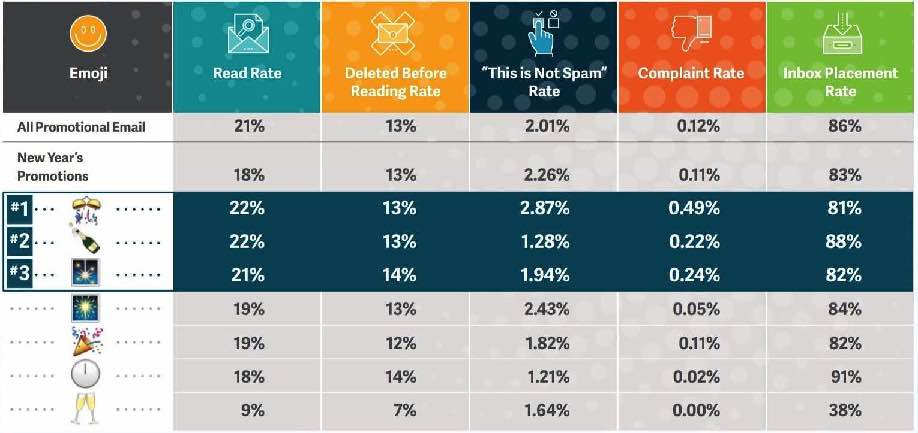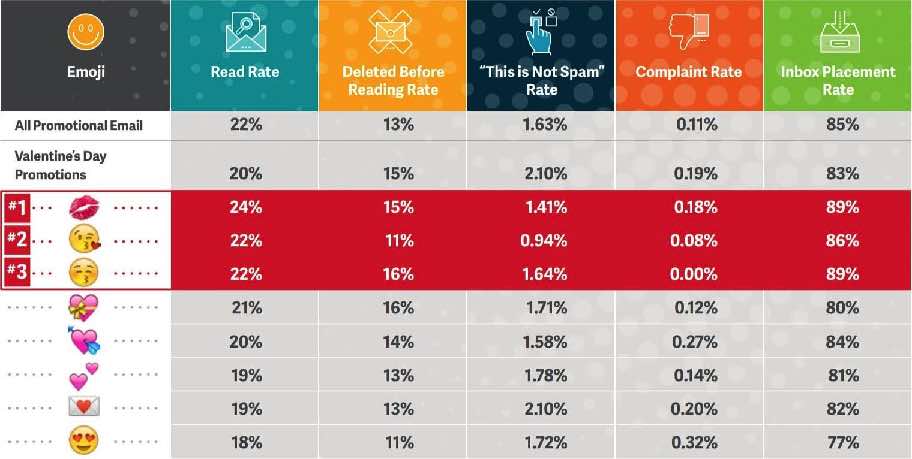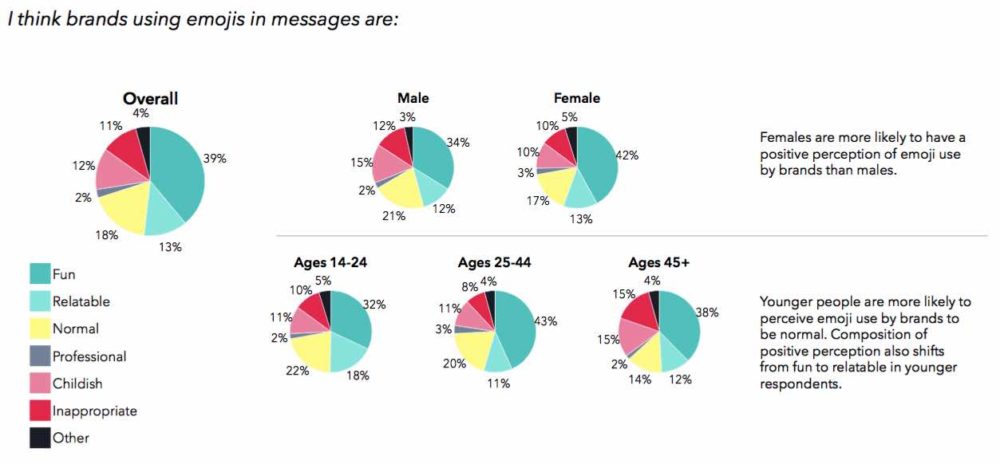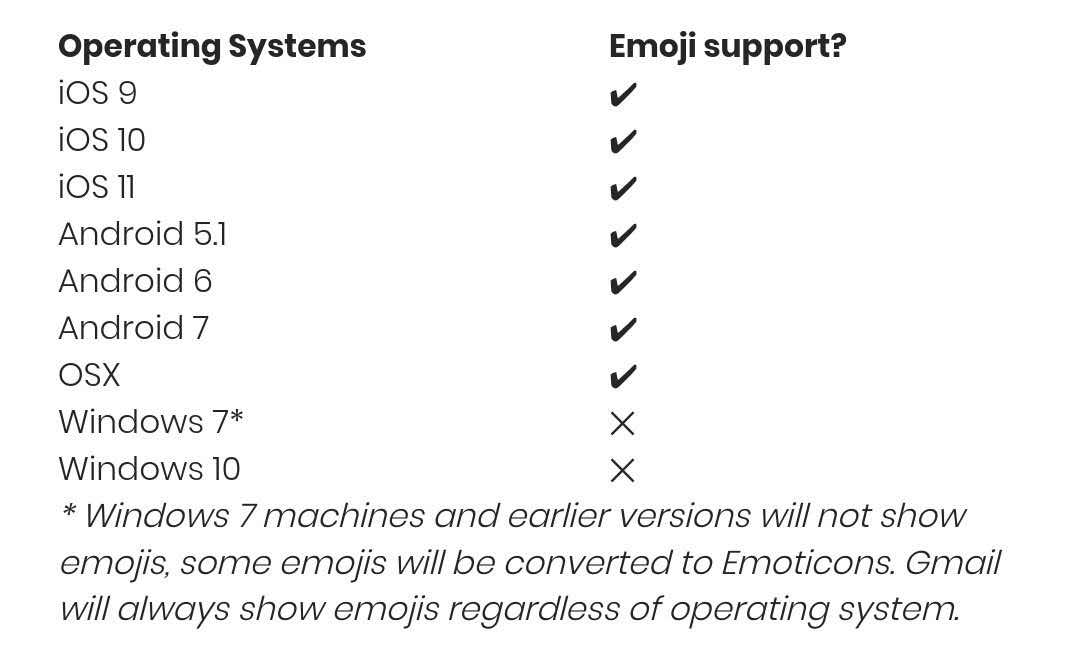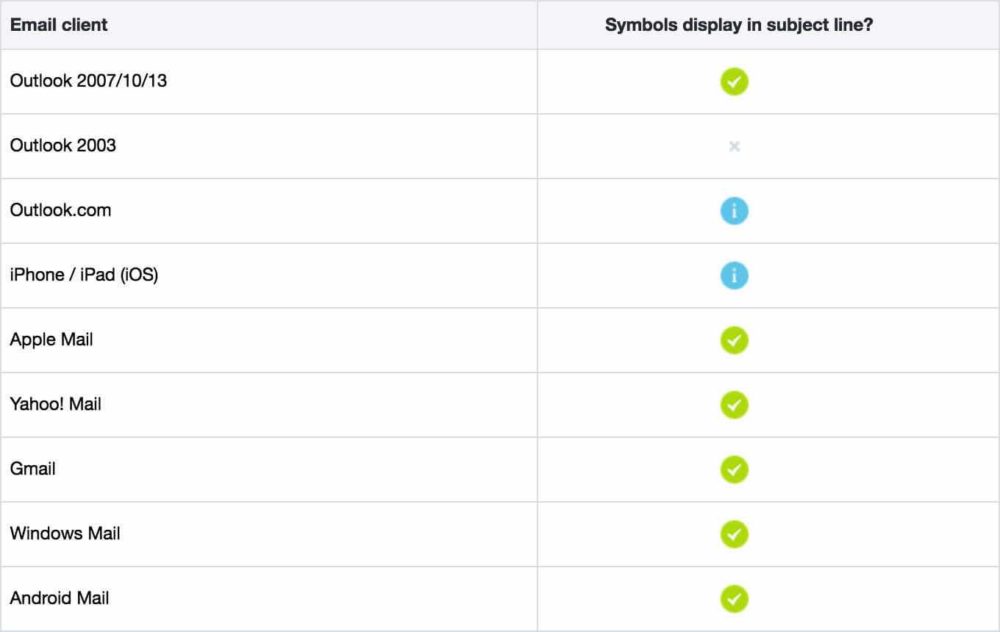Emojis are the pineapple on pizza for marketers.
Some love them, some hate them, but I’ve never met anyone indifferent to them. The idea for this article came to me when I myself got annoyed by a particularly irritating ???? sitting in my inbox on a busy Monday morning. “There’s no way emojis in email can work,” – I thought, but I had to check.
And so I did. There are multiple articles on emojis in emails, but all of them seem to be losing their relevance, which is why I have collected the most relevant data to create the Ultimate Guide.
30
default
Do Emojis Improve Email Open Rate?
Short answer: Sometimes.
Long answer: It depends on many factors, including timing, audience, and emojis used.
Having read and analyzed multiple studies, I can say one thing for certain – there is no sure-fire formula for using emojis that will give you an improved open rate every time. Here’s why.
Timing
One of the more recent studies on emojis in email found that some seasonal and themed emojis do improve open rate, while others majorly reduce it. This unpredictability is what makes it so hard to give a definitive answer on emojis’ use.
30
default
30
default
Check the stats on this New Year’s promotion above. Pay attention to two of the control rates: 18% read rate and 0.11% complaint rate.
The Top 3 emojis performed 3-4% better than average in terms of read rate, yet received 2-4 times the average complaint number.
What does this tell us? That emojis don’t provide consistent results.
Let’s check another example.
30
default
30
default
With the average Valentine’s Day promo stats of 20% read rate and 0.19% complaint rate, this seemingly similar promo shows us more positive results.
Top 3 emojis yielded a 2-4% better read rate, yet received much lower complaint rates.
Note that the read rate with and without emojis is the same when compared to the All Promo Email average stats.
Audience
Many are convinced that the success of emojis depends on how well you know your target personas, and I agree. Sometimes that includes understanding that emojis are not for your audience, too.
Younger vs Older
Common sense would tell you that younger audiences like Millennials and Gen Z are more likely to engage with emojis, and research confirms that. A survey found that 68% of millennials prefer communicating with emojis and gifs, and only 37% of those over 65 agree with them. We can only assume the % is even higher among Gen Z.
B2B vs B2C
B2B emails tend to take on a slightly more serious tone, which makes using emojis in emails not just risky, but inappropriate. B2B emails are closer to work communication than a mass email campaign, and a research on email faux pas shows that emojis are considered unacceptable by 30% of responders, so save that for close business contacts.
Existing Customers/Clients vs Leads
Don’t underplay the importance of your relationship with your subscribers. Emojis bring a sense of familiarity with them, which at times is not something you can afford with leads, especially the cold ones. For example, a study called Effects of Smiling Emoticons on Virtual First Impressions found that “…Smileys do not increase perceptions of warmth and actually decrease perceptions of competence. Perceptions of low competence in turn undermined information sharing.”
Women vs Men
A study by Braze (formerly Appboy) found that men are more likely to have a negative reaction to emojis (13% vs 4%). This great chart from the study shows even more details about how people view brands using emojis in messages (including email).
30
default
30
default
This same study also researched the channels through which people are most open to brands using emojis, with text messages receiving 37%, social media – 28%, and email getting 14%.
Location
In a somewhat unexpected turn, a study by Mailjet found that among Spain, France, the UK and the US, all countries had radically different reactions to emojis. In France, all tested emojis in subject lines resulted in lower open rates (-11%), while in the US and the UK the use of emojis saw a growth in open rates (+42% and +62% respectively).
Emojis Used
As we’ve seen in the first graph, different emojis receive different reactions. In another great study, Braze found that ❤️ is currently the most commonly used emoji. Bear in mind, however, that the less popular emoji you use, the higher the chances to catch your recipient’s attention in the crowded inbox.
Why? Because the insane popularity of the heart emoji means that the audience is seeing a lot of messages with the same emojis again and again, quickly growing tired of this once – exciting marketing trick. This is confirmed by another big study from Phrasee, according to which 100 most common emojis make up 66% of all emojis used in email subject lines.
As of this summer, there are 3,823 emojis, with 279 new emoji candidates planned for next year. If you’re not afraid to use emojis in the first place, why not experiment with some of the underrated ones? Why not try to use this little fella ???? in your next campaign? Or, why not start using data-driven email marketing campaigns for your overall strategy?
30
default
Do you want to increase your conversions and sales with email marketing?
center
no-repeat;center top;;
auto
30
default
Do Emojis Improve The CTR?
Yes and no. Emojis increase the CTR in a lot of mediums. However, it hasn’t been proven that email is one of them.
The closest stats we have are from a research that claims that 45% of consumers “like brands that do not take themselves too seriously”. But claiming that the human-ness of emojis will improve your CTR is a reach.
30
default
Why Should I Use Emojis In Email Subject Lines?
If you are looking for reasons to use emojis that aren’t connected to improving your CTR or open rates, there’s plenty.
● Emojis can convey more information is less characters.
According to a report by Edison, 85% of American use smartphones to access their email, which means you have to pique their interest in 40 characters or less. Emojis are a perfect trick to achieve that.
● Emojis have a higher ability to convey emotion.
And more emotions means your email is more memorable to the recipient. They are also a great way to convey humor.
● Emojis still stand out in the inbox.
While the peak of emoji popularity probably falls somewhere around 2018, it is still pretty unusual to find one in your inbox still nowadays. Which means it will catch your recipients’ attention.
● Emojis can help build brand recognition.
If you happen to find an emoji that seems to perfectly represent your brand’s image, it might be a great idea to use it in an email. If you have an emoji idea in mind, you can even submit your own to Unicode. A consistent but balanced use of emojis in email newsletters can also help.
● Emojis feel relatable to younger generations.
Emojis is a separate language and if you happen to come across a new emoji or a combination popular within your target demographic, you might see a rise in your statistics.
30
default
What Are The Cons Of Using Emojis?
The influence of emojis is too unpredictable to have any tangible reasons against them. To create great email marketing campaigns, you need to be careful to the use of emojis. The misuse of them can be disastrous.
● Stylistic preferences
While we’ve established the stats by age, gender, profession, location etc, it’s important to remember that humans are not just numbers, and even if your emoji subject line performed well in testing, a personal stylistic preference of the recipient may not always be in line with the majority. Use your critical thinking, especially when working with individual emails and not campaigns.
● Different rendering on different platforms
We’ll dwell on this a little more further on, but as you may know, different platforms display emojis differently. Be mindful of that.
● Gradual loss of novelty
Many have expressed worry that email marketers might soon oversaturate the emails with emojis. This worry is not unfounded: another research from Mailjet found that the growth in open rates caused by emojis has been gradually going down.
● Boosting impact
Emojis enhance the initial subject line, meaning bad lines will seem worse, and good lines will get better. It’s unwise to expect a good emoji to save your subject line. Make sure every element can stand on its own.
● Triggering of spam filters
While this point has not actually been studied or proven, I feel the need to include it just in case. Be mindful of the number of emojis you are including in your subject line.
● Ambiguity
According to Oxford University Press article, some emojis can be too ambiguous in meaning. Use this to avoid any awkwardness and have a few people from your team double check to make sure your message is coming across correctly.
30
default
It’s time to improve your email marketing strategy!
center
no-repeat;center top;;
auto
30
default
What Should I Check Before I Use Emojis?
When it comes to emojis in subject lines, there’s really only two things you should definitely check.
A/B Testing
Like with any other email campaigns, you have to A/B test your subject line. You need to do this to make sure your audience is responding the way you need it too. There really isn’t much else to say about this: test the emoji subject lines on a small sample of your email list and compare the results to a control group. You can do this for free by launching a small email drip campaign with Snov.io’s cold email sender and check the open and click rates in real time.
Rendering
Incorrect rendering of emojis is what’s stopping a lot of marketers from using them en masse. There are two problems: emojis may appear different on different platforms and operating systems, conveying the wrong message, or they may not show up at all. These may seem like major problems, but the truth is they are easily solved.
For this you will need a couple of resources. First, check out this table from EmailOnAcid.com.
30
default
30
default
Once you’ve checked this, take a look at this table from Campaign Monitor to check which platforms support emojis in subject lines.
30
default
30
default
Now that you’re sure your emojis will show up in the email subject line, check if they will be rendered the way you need them to to best convey your message. For this, you can use the following resources:
● Full Emoji List by Unicode will help you see how your emoji will be rendered across different platforms.
● Emojipedia serves a similar purpose, plus makes it easy to find and copy paste necessary emojis.
● Caniemoji.com lets you check the current status of native emoji support across iOS, Android and Windows.
Please note that even though Gmail will always display emojis, if you try to copy paste the Gmail emoji from email body to email subject line, you will see a ☐ instead. Use one of the resources mentioned above.
If for some reason your emoji doesn’t display right, you have to make sure your subject line doesn’t suffer because of it.
30
default
Tips For Using Emojis In Email Subject Lines
There isn’t much that’s not been covered already, but I’ve gathered a couple of additional tips anyway:
● Establish clear guidelines on emoji use for your team based on the research and testing of your target audiences.
● Make sure your subject line is great even without the emoji.
● Ask yourself if you’re using the emojis just for the sake of using them (and if yes, then probably don’t).
● Analyze your stats regularly to make sure you’re not overusing emojis to the point where it hurts your campaigns.
● Make sure your emojis are inoffensive. Get a second opinion if you’re not sure.
30
default
Final thoughts about using emojis in email subject lines
The use of emojis in your email subject lines could be added to these email marketing growth hacks. It’s safe to say that emojis are a very neutral element of email subject lines. They do not affect the statistics enough to talk about any revolutionary approaches. The truth is, emojis are simply fun and sometimes that’s good enough to spice up your campaigns.
The open rates and CTR depend more on the full subject line and other elements of your email, so make sure to pay enough attention to those. If you do choose to use emojis in your email subject lines, don’t forget to target, test, and check emoji rendering.
Growth Hackers is a modern email marketing company helping businesses from all around the world grow. We help local businesses, early-stage startups, funded startups, entrepreneurs and established businesses with online marketing (Email marketing, Search Engine Optimization, Online Advertising, Content Marketing…) and growth hacking (Conversion Rate Optimization, Data Analysis, Products’ Improvements…). Through the different growth marketing channels we use, our clients get their processes automated, their lead generation funnels are implemented and their sales increase. Give Growth Hackers a shoot now if you want to get help in growing your brand.
30
default
Grow your Business with Email Marketing and More Digital Marketing Strategies!
https://www.growth-hackers.net/contact/
center
icon-chart-bar
right
#4FA456
white
3


